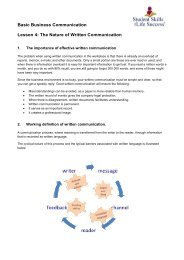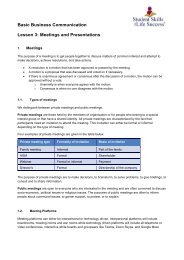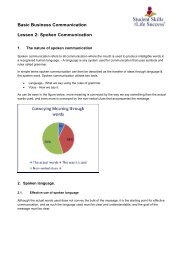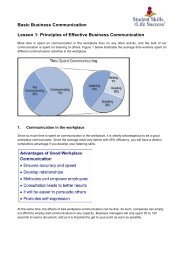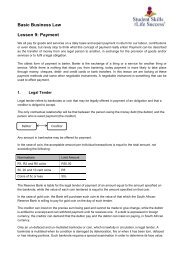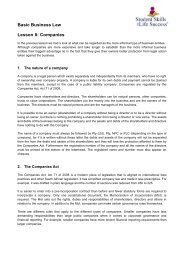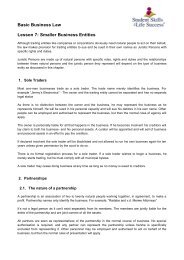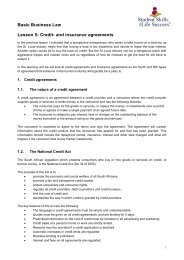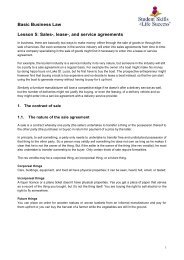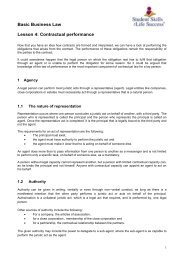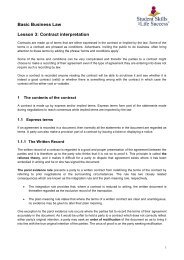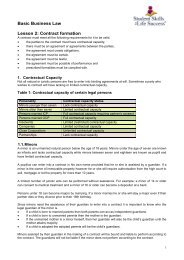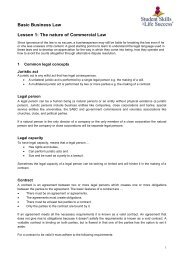Purchasing and Financing 2024
Purchasing- and Financial Management For 2nd year CATS learners. Aligned to the outcomes of the German accredited certification: “Industrie Kaufmann/frau”.
Purchasing- and Financial Management
For 2nd year CATS learners.
Aligned to the outcomes of the German accredited certification: “Industrie Kaufmann/frau”.
Create successful ePaper yourself
Turn your PDF publications into a flip-book with our unique Google optimized e-Paper software.
Changes in working capital will impact a business’ cash flow. When working capital<br />
increases, the effect on cash flow is negative. This is often caused by the liquidation of<br />
inventory or the drawing of money from accounts that are due to be paid by the business.<br />
On the other h<strong>and</strong>, a decrease in working capital translates into less money to settle<br />
short-term debts.<br />
3. THE CASH CYCLE<br />
Students can describe the cash cycle <strong>and</strong> are able to distinguish between Income vs.<br />
Cash Inflow <strong>and</strong> Expenses vs. Cash Outflow, as well as <strong>Financing</strong> vs. Investments.<br />
Sometimes referred to as a cash conversion cycle, the cash cycle has to do with the<br />
amount of time that passes between the purchase of raw materials for the creation of<br />
goods <strong>and</strong> services <strong>and</strong> the receipt of payment for those products. A key factor in the idea<br />
behind calculating the cash cycle is to underst<strong>and</strong> the period of time when working capital<br />
is not available for use in other purchases.<br />
In a manufacturing process, the cash cycle begins with the acquisition of the materials<br />
needed to produce finished goods. The cycle continues through the time required to<br />
utilize the materials to create the products, package them, <strong>and</strong> deliver them to customers.<br />
Once the client is invoiced for the delivered goods, the last step of the cash cycle begins. A<br />
cash cycle is considered complete when the Accounts Receivable department receives <strong>and</strong><br />
posts payment in full on the invoice covering the delivered goods.<br />
The duration of a cash cycle will vary, depending on several factors, including;<br />
o The amount of time that is required to create the product<br />
o The amount of time spent inspecting, packaging <strong>and</strong> shipping the finished product<br />
o The amount of time that it takes for the client to remit payment for the finished<br />
goods<br />
A short cash cycle is the ideal situation, as it allows the company to take advantage of the<br />
working capital sooner rather than later. Two ways to shorten a cash cycle are;<br />
o To refine the manufacturing <strong>and</strong> shipping procedures<br />
o To offer incentives to the customer to pay for the goods quickly<br />
The activities of a company relate to the cash flow as follows:<br />
o Goods are purchased <strong>and</strong> consequently there’s an outflow of money<br />
o While the goods are combined in the production process, there’s no inflow of<br />
money<br />
o The finished goods must now be sold <strong>and</strong> waiting for the customer to pay takes<br />
time so that the inflow of cash is delayed<br />
28




